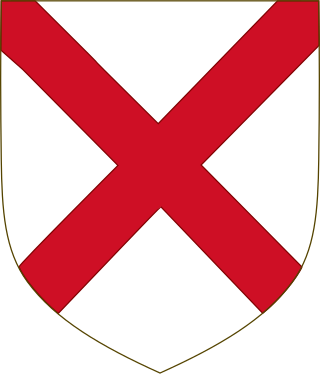| |||||
| Centuries: | |||||
|---|---|---|---|---|---|
| Decades: | |||||
| See also: | Other events of 1510 List of years in Ireland | ||||
Events from the year 1510 in Ireland.
| |||||
| Centuries: | |||||
|---|---|---|---|---|---|
| Decades: | |||||
| See also: | Other events of 1510 List of years in Ireland | ||||
Events from the year 1510 in Ireland.

Duke of Leinster is a title in the Peerage of Ireland and the premier dukedom in that peerage. The subsidiary titles of the Duke of Leinster are: Marquess of Kildare (1761), Earl of Kildare (1316), Earl of Offaly (1761), Viscount Leinster, of Taplow in the County of Buckingham (1747), Baron of Offaly, Baron Offaly (1620) and Baron Kildare, of Kildare in the County of Kildare (1870). The viscounty of Leinster is in the Peerage of Great Britain, the barony of Kildare in the Peerage of the United Kingdom, and all other titles in the Peerage of Ireland. The courtesy title of the eldest son and heir of the Duke of Leinster is Marquess of Kildare. The Duke of Leinster is the head of the House of Kildare.

Lieutenant-General James FitzGerald, 1st Duke of Leinster, PC (Ire), styled Lord Offaly until 1743 and known as The Earl of Kildare between 1743 and 1761 and as The Marquess of Kildare between 1761 and 1766, was an Anglo-Irish nobleman, soldier and politician.

The FitzGerald dynasty is a noble and aristocratic dynasty of Cambro-Norman and Anglo-Norman origin. They have been peers of Ireland since at least the 13th century, and are described in the Annals of the Four Masters as having become "more Irish than the Irish themselves" or Gaels, due to assimilation with the native Gaelic aristocratic and popular culture. The dynasty has also been referred to as the Geraldines and Ireland's largest landowners. They achieved power through the conquest of large swathes of Irish territory by the sons and grandsons of Gerald de Windsor. Gerald de Windsor was the first Castellan of Pembroke Castle in Wales, and became the male progenitor of the FitzMaurice and FitzGerald Dynasty. His father, Baron Walter FitzOther, was the first Constable and Governor of Windsor Castle for William the Conqueror, and was the Lord of 38 manors in England, making the FitzGeralds one of the "service families" on whom the King relied for his survival.
The Lord Deputy was the representative of the monarch and head of the Irish executive under English rule, during the Lordship of Ireland and then the Kingdom of Ireland. He deputised prior to 1523 for the Viceroy of Ireland. The plural form is Lords Deputy.

Thomas FitzGerald, 10th Earl of Kildare, also known as Silken Thomas, was a leading figure in 16th-century Irish history.
Sir James OrmondaliasButler was the son of John Butler, 6th Earl of Ormond. He was Lord Treasurer of Ireland from 1492 to 1494, and helped to defend the Lordship of Ireland against the forces of Perkin Warbeck. He was murdered by Sir Piers Butler on 17 July 1497. Piers would later hold the title of Earl of Ormond.

Maynooth Castle is a ruined castle in Maynooth, County Kildare, Ireland which stands at the entrance to the South Campus of Maynooth University. Constructed in the early 13th century, it became the primary residence of the Kildare Fitzmaurice and Fitzgerald family.
The Battle of Knockdoe took place on 19 August 1504 at Knockdoe, in the Parish of Lackagh, County Galway, between two Anglo-Irish lords—Gerald FitzGerald, Earl of Kildare, the Lord Deputy of Ireland, and Ulick Fionn Burke, 6th Clanricarde (d.1509)—along with their respective Irish allies. The cause was a dispute between Maelsechlainn mac Tadhg Ó Cellaigh (O'Kelly), King of Ui Maine – Mod. Irish Uí Mháine) and Clanricarde. The major contemporary sources for this battle are the Gaelic Irish annals and a sixteenth-century manuscript written in the Pale known as "the Book of Howth".

Gerald FitzGerald, 11th Earl of Kildare, also known as the "Wizard Earl", was an Irish peer. He was the son of Gerald FitzGerald, 9th Earl of Kildare and his second wife Elizabeth Grey of the Royal House of Grey.

Maurice FitzGerald, Lord of Maynooth, Naas, and Llanstephan (born: almost certainly not at Windsor Castle, more likely Carew in Wales c.1105 – September c.1176 Wexford, Ireland. He was a medieval Anglo-Norman baron and a major figure in the Norman Invasion of Ireland.
George FitzGerald, 16th Earl of Kildare was known as the "Fairy Earl", apparently for no other reason than that his portrait, which is extant, was painted on a small scale."
Events from the year 1513 in Ireland.
Events from the year 1534 in Ireland.
Events from the year 1585 in Ireland.
Fitzmaurice is a Hiberno-Norman, Cambro-Norman, Anglo-Norman surname. It is patronymic as the prefix Fitz-
derives from the Latin filius, meaning "son of".

William MacWilliam O'Brien, 8th Baron of Inchiquin, 3rd Baron O'Brien of Burren, 3rd Earl of Inchiquin PC was an Irish nobleman.
John FitzGerald, 18th Earl of Kildare, styled Lord Offaly until 1664, was an Irish peer.
Robert FitzGerald, 19th Earl of Kildare PC (Ire), known as Robert FitzGerald until 1707, was an Irish peer.

Gerald FitzGerald, 8th Earl of Kildare KG, known variously as "Garret the Great" or "The Great Earl", was Ireland's premier peer. He served as Lord Deputy of Ireland from 1477 to 1494, and from 1496 onward. His power was so great that he was called "the uncrowned King of Ireland".
The Battle of Thomond was fought in Ireland on 14 July 1328 between the forces of William de Burgh and an army led by Brian Bán Ó Briain, Lord of Thomond. It was fought near Thurles in modern County Tipperary and featured powerful Gaelic and Anglo-Irish figures on both sides.